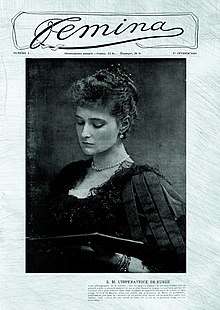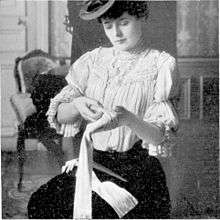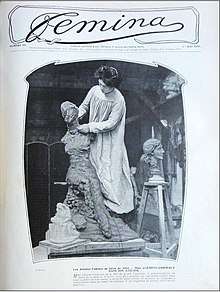Femina (France)
Femina is a French magazine created on February 1, 1901 by Pierre Lafitte and discontinued in 1954. The title gave its name to the Femina award from 1922[1]


History
The title of this illustrated periodical is taken from the Latin word femina for "woman". It was subtitled "La revue idéale de la femme et de la jeune fille" ("The ideal magazine for women and girls") and was an early French magazine format targeting a female readership of the bourgeoisie, with generous coverage of leisure activities, especially sports; the cover of April 1, 1902 shows the photograph of two women playing ping pong. Another magazine published by Lafitte, La Vie au vent, catered to women sports enthusiasts.[2]
On October 15, 1902, Hachette launched a competing monthly entitled La Vie heureux, subtitled "revue féminine universelle illustrée" ("Universal Illustrated Women's Magazine"), which gave its name to a literary prize in November 1904, awarded by a jury of women of letters.
Contents

As an example of its contents and inclusion of female celebrities of the day, the May 1, 1903 issue entitled "Women Artists at the Salon of 1903", devoted three illustrated pages to Louise Abbéma, Louise Catherine Breslau, Camille Claudel, Maximilian Guyon, Louise Clément-Carpeaux (cover), Laure Coutan-Montorgueil, Juana Romani.
Current fashion was illustrated with photographs made in the studio or at social events (such as those taken at the races by the Séeberger Brothers)[3] and hand-drawn illustrations, including instructions on fitting garments; on the correct way to remove gloves, for example.
After a few years, the cover of the magazine, which was in most cases a photograph, was alternated with a bi-chrome comic illustration. In 1906, the cover of the November 1 number displayed drawing of a woman breastfeeding her child, signed by Paul César Helleu.
In 1909, the Académie française raised the question of the election of female members: immediately, Femina asked its readers to nominate 40 women writers, contemporary or former, who would constitute an imaginary female academy and published on a double-page an illustration showing the 40 elected standing under the dome of the academy.
Later years
After having suspended publication in 1917, Pierre Lafitte sold his title to Hachette, who merged it with La Vie heureux, keeping the name Femina and launching a new monthly formula in January 1922. The "Femina-La Vie Heureuse Prize" was then renamed Femina prize.
The magazine was then issued regularly until 1939 with Lafitte and Robert Ochs as co-editors (who became editor in 1935) and Martine Rénier as fashion editor.
It reappeared as a luxurious version quarterly and with out-of-series editions in colour from 1945, sometimes illustrated by significant artists, before disappearing after a number dated December 1953-January 1954.
Editorial direction
Anne R. Epstein, in her review of the book by Colette Cosnier, Les Dames de Femina[4] raises the question of the editorial orientation of the magazine, recalling that its readership was essentially composed of bourgeois women with conservative tendencies. Indeed, Pierre Lafitte did not have the goal, originally, to publish a feminist magazine, but rather a women's magazine:
The ambitions and editorial strategy of Pierre Lafitte, director of the publication, was inspired by the success of the English 'Ladies Magazine'. He envisioned a magazine representing luxury, trends, everyday life and family: it is the forerunner of "people" magazines and lifestyle and fashion guides for the affluent woman."
However, given feminist advances of that time, including the suffragettes' demands in England, and achievement of the right to vote by Danish women, such issues are discussed in the magazine. In addition, Lafitte showcased the sporting abilities of women, launching several prizes in the context of competitions (related to golf, in particular), including the Femina Cup in 1906.
Other titles
Version Femina (Lagardère group) is the title of an unrelated contemporary publication for women, and Femina is also the name women's magazines in Denmark, Femina (India), an Indian bimonthly, Femina (Indonesia), an Indonesian weekly, and Femina (South Africa), a monthly women's magazine published in South Africa, and one in Switzerland, as well as a women's magazine with text in Esperanto.
References
- prixfemina.org Sylvie Ducas, "Le prix Femina : la consécration littéraire au féminin", Recherches féministes, vol. 16, no 1, 2003, p. 43-95 (ISSN 0838-4479, online [archive])
- Lenard R. Berlanstein, "Selling Modern Femininity: Femina, a Forgotten Feminist Publishing Success in Belle Epoque France," French Historical Studies, vol. 30, No. 4, Fall 2007, p. 623-649 (DOI 10.1215 / 00161071-2007-010)
- Aubenas, Sylvie; Séeberger, Henri; Séeberger, Jules; Séeberger, Louis; Chardin, Virginie; Demange, Xavier (2007), Elegance : the Séeberger brothers and the birth of fashion photography 1909-1939, translated by Michelli, Pippin (1st American ed.), Chronicle Books, ISBN 978-0-8118-5942-4
- Colette Cosnier, Les Dames de Femina. Un féminisme mystifié, Rennes, Presses universitaires de Rennes, 2009, 308 p. (ISBN 978-2-7535-0812-5)